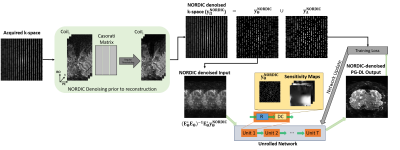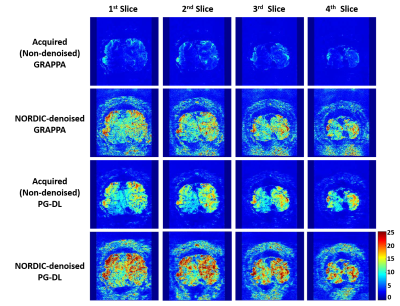3450
High-Quality 0.5mm Isotropic Functional MRI Using a Synergistic Combination of NORDIC Denoising and Deep Learning Reconstruction1Electrical and Computer Engineering, University of Minnesota, Minneapolis, MN, United States, 2Center for Magnetic Resonance Research, University of Minnesota, Minneapolis, MN, United States, 3Department of Neurosurgery, University of Minnesota, Minneapolis, MN, United States
Synopsis
Submillimeter fMRI allows studying brain function at the mesoscale level, but scans at such resolutions require trade-offs in SNR and coverage, necessitating better image reconstruction. In this work, we combine NOise Reduction with Distribution Corrected (NORDIC) denoising prior to image reconstruction with self-supervised physics-guided deep learning (PG-DL) for high-quality 0.5mm isotropic fMRI. The former removes components of image series that cannot be distinguished from thermal noise, while the latter enables higher acceleration rates. Results show that the proposed combination of NORDIC and PG-DL improves on NORDIC or PG-DL alone, both visually, and in terms of tSNR and GLM-derived t-maps.
INTRODUCTION
Though fMRI has revolutionized our understanding of the human brain, higher resolutions are desirable to study brain function at the mesoscale level1. However, this requires trade-offs between SNR, spatio-temporal resolution and coverage2. Recently, NOise Reduction with Distribution Corrected (NORDIC) denoising method was proposed to suppress the noise components of image series that cannot be distinguished from thermal noise3,4. NORDIC was originally applied after parallel imaging reconstruction, which hinders its use in accelerated high spatio-temporal applications, where parallel imaging may suffer from aliasing artifacts. On the other hand, physics-guided deep learning (PG-DL) reconstruction has recently gained immense interest for improving highly-accelerated MRI5. Yet, such non-linear reconstruction does not lead to a well-understood reconstruction noise distribution, which is essential for NORDIC post-processing3. Nevertheless, recently NORDIC has been applied before parallel imaging reconstruction6, but its combination with DL remains unclear. In this work, we synergistically combine NORDIC denoising and PG-DL reconstruction for high-quality reconstruction of 0.5mm isotropic resolution fMRI data. Our results show that combining PG-DL and NORDIC substantially improves upon using NORDIC or PG-DL alone.METHODS
Imaging Experiments: fMRI acquisitions were performed at 7T (Siemens Magnetom) using 32-channel NOVA head coil. A T2*-weighted 3D GE-EPI sequence was used, covering 40 slices with TR=83ms (VAT=3654 ms)4. TE=32.4 ms, α =13°, bandwidth=820Hz, in-plane acceleration R=3, partial-Fourier=6/8, 0.5mm isotropic nominal resolution4. 8 runs, each lasting ~5:30mins (3 trials, 2 conditions) were collected with a standard 24s on-off visual block design paradigm with a center/target and surround checkerboard counterphase flickering (at 6 Hz).NORDIC Denoising Pre-reconstruction: NORDIC uses locally low-rank (LLR) properties of image patches across image series3,4. In its original version, following parallel imaging, complex-valued reconstruction noise spectrum is flattened based on g-factor maps, and singular value thresholding (SVT) is applied with a parameter-free threshold determined from random matrix theory. Alternatively, recent work has applied NORDIC to the undersampled data6, noting that with uniform undersampling, aliased folded-over image patches also have LLR properties due to the subadditivity of matrix rank. Prior to reconstruction, NORDIC denoising is applied on each channel of the undersampled k-space, and g-factor normalization is not required.
PG-DL Reconstruction: Regularized MRI reconstruction solves:
$$\\arg \min_{\mathbf{x}} \left\| \mathbf{y}_{\Omega}-\mathbf{E}_{\Omega}\mathbf{x} \right\|_{2}^{2} + {\cal{R}}(\mathbf{x}),$$
where $$$\mathbf{y}$$$ is acquired k-space with undersampling pattern $$$\Omega$$$, $$$\mathbf{x}$$$ is the image, $$$\mathbf{E}_{\Omega}$$$ is the multi-coil encoding operator. In PG-DL, algorithm unrolling is used to solve this objective function, leading to a data consistency (DC) and regularization sub-problem at each unroll12. Note conventional supervised training cannot be applied due to the lack of fully-sampled training data at such high resolutions. Thus, self-supervised learning via data undersampling (SSDU) strategy is used8,9, which splits $$$\Omega$$$ into two disjoints sets, where one is used in DC units and the other to define k-space loss8,9.
Implementation Details: NORDIC was applied to acquired data after pre-whitening and navigator-correction. SVT was performed independently on each channel using a spatio:temporal ratio of 11:1. Two PG-DL networks were trained separately on non-denoised and NORDIC-denoised raw k-spaces of 2 subjects with 4 runs/subject, using multi-mask SSDU with parameters from9. Only one-time frame per subject was used to avoid temporal blurring. Fig. 1 shows a schematic of the implementation.
Non-denoised and NORDIC-denoised raw k-spaces of a different subject were reconstructed using both GRAPPA and PG-DL.
Data Analysis: Functional preprocessing included 3D rigid body motion correction and low-drift removal (3rd order DCT). Standard GLM analyses were carried out on all runs concatenated for each reconstruction independently.
RESULTS
Fig. 2 shows a representative reconstructed slice. Non-denoised GRAPPA reconstruction suffers from noise amplification, which is reduced by NORDIC followed by GRAPPA (NORDIC+GRAPPA). PG-DL reconstruction on acquired k-space also has substantially reduced noise compared to GRAPPA alone, and slightly less noise than NORDIC+GRAPPA though with some loss of detail. The proposed combination of NORDIC and PG-DL reduces noise the most, while preserving fine details.Fig. 3 depicts tSNR maps of four slices for all methods. GRAPPA on the acquired k-space has the lowest tSNR, while NORDIC+GRAPPA provides substantial tSNR gain. PG-DL applied on non-denoised data shows similar tSNR to NORDIC+GRAPPA, but has lower tSNR around the brain periphery. PG-DL reconstruction on NORDIC-denoised k-space shows the highest tSNR, including gains in central brain regions.
Fig. 4 shows GLM-derived t-maps for the contrast target and surround >0 for all reconstructions. Standard images are dominated by thermal noise, leading to no meaningful activation (leftmost). NORDIC+GRAPPA and PG-DL allow retrieval of the retinotopically expected extent of activation. The combination of NORDIC and PG-DL leads to the largest expected extent of activation.
DISCUSSION AND CONCLUSIONS
In this work, we proposed a synergistic combination of NORDIC denoising and self-supervised PG-DL reconstruction for high-quality 0.5mm isotropic resolution fMRI. Results showed that this improved on NORDIC or PG-DL alone, both in terms of tSNR and GLM-derived t-maps. NORDIC provides an interpretable approach to denoising, removing components not distinguishable from thermal noise, while PG-DL offers improved artifact removal compared to parallel imaging. While PG-DL alone reduces noise, it also degrades in sharpness, which is maintained by the proposed combination of NORDIC and PG-DL. Further investigations at higher acceleration rates are warranted to harness the full potential of the proposed combination for unprecedented spatial resolutions.Acknowledgements
Funding: Grant support: NIH, Grant numbers: P30 NS076408, R01 HL153146, U01 EB025144, P41 EB027061, RF1 MH116978; NSF, Grant number: CAREER CCF-1651825. The first three authors contributed equally.
References
[1] N. K. Logothetis, “What we can do and what we cannot do with fMRI,” Nature, vol. 453, no. 7197, pp. 869–878, 2008.
[2] D. C. Van Essen, S. M. Smith, et al., “The WU-Minn Human Connectome Project: an overview,” Neuroimage, ol. 80, pp. 62–79, 2013.
[3] S. Moeller, et al., “NOise reduction with DIstribution Corrected (NORDIC) PCA in dMRI with complex-valued parameter-free locally low-rank processing”. Neuroimage, 226:117539.
[4] L. Vizioli, et al., “Lowering the thermal noise barrier in functional brain mapping with magnetic resonance imaging”. Nat Commun, 12, 1:5181.
[5] K. Hammernik, T. Klatzer, et al., “Learning a variational network for reconstruction of accelerated MRI data,” Magn Reson Med, vol. 79, pp. 3055–3071, 2018.
[6] S. Moeller, et al., “NORDIC denoising before image reconstruction.,” in Proc ISMRM, 2021.
[7] Fessler, Jeffrey A. "Optimization methods for magnetic resonance image reconstruction: Key models and optimization algorithms." IEEE Signal Processing Magazine 37.1 (2020): 33-40.
[8] B. Yaman, S. A. H. Hosseini, et al., “Self-supervised learning of physics-guided reconstruction neural networks without fully sampled reference data,” Magn Reason Med, vol. 84, no. 6, pp. 3172–3191, 2020.
[9] O. B. Demirel, B. Yaman, et al., “20-fold accelerated 7T fMRI using referenceless self-supervised deep learning reconstruction,” arxiv preprint arXiv:2105.05827, 2021.
Figures



